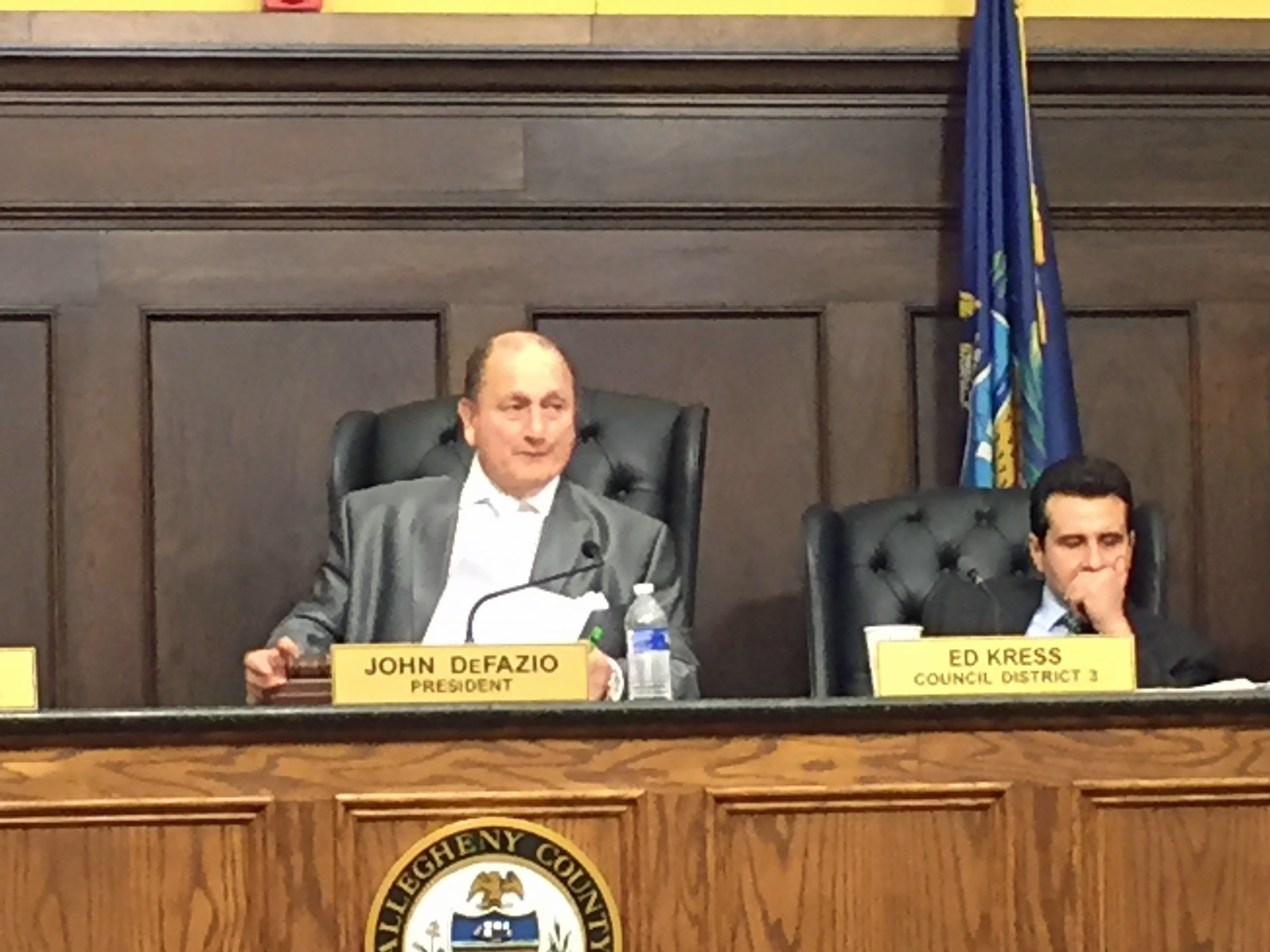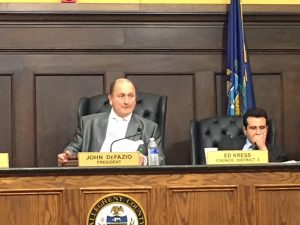Knit the Bridge was in the Post Gazette once again — but we’re not so happy this time. Diana Nelson Jones reported on the vote before Allegheny County Council to remove the never enacted 2% set-aside for public art. In the article, Amie Downs, official spokesperson for County Executive Rich Fitzgerald, cited KtB as an example of why the set-aside was unnecessary with an ambiguous description of the type of support the county provided to the project. “We have focused our time and efforts on cataloging and maintaining existing public art, while encouraging and supporting public art in the community. The Knit the Bridge installation is just one such example.”
FGP President Susan Swarthout contacted the KtB team concerned that using it as an example sent the wrong message to the arts community and the entire region. The KtB team agreed and on Tuesday November 17, Knit the Bridge lead artist and co-director, Amanda Gross, co-director Penny Mateer and current and former Presidents of the Fiberarts Guild of Pittsburgh Susan Swarthout and Sherri Roberts all provided comment at the County Council’s bimonthly November meeting. FGP recommended that County Council vote no to the elimination of the 2% set aside and yes to the creation of the arts board.
FGP was joined by approximately 15 artists and art advocates who provided comment at the meeting including Renee Piechocki Office of Public Art, David Pankratz Policy guru at Greater Pittsburgh Arts Council and Carolyn Speranza PGH4ART.
Amanda was the first to comment from KtB and emphasized that the success of our project was attributed to the types of networks we were able to access “(KtB) happened because the supporting organization (the Fiberarts Guild) and core group of organizers have a base of race privileged and affluent networks.” After she clarified that KtB received no government funds she stressed that a change in Public Art policy would reduce broad community access. Amanda continued “Cutting off democratic public access will disproportionately impact artists without wealth and artists of color. This serves to make Allegheny County’s public sphere even less inclusive which is an embarrassing step in the wrong direction, especially given Pittsburgh’s low diversity ratings and the absence of people of color from many prominent political and cultural arenas.”
Sherri followed by expressing her outrage that the ordinance had been ignored for so long and that we had no idea there even was one during our negotiations with the county. Accentuating the positive outcomes public art brings, she cited a PG article on September 6, 2013 “… the Andy Warhol Museum…saw an increase in visitors during the month of August over last year—up from 9,520 in 2012 to 10,560 this year, an increase of 1,040.” Sherri continued with another example provided by the executive director of Cuyahoga Arts and Culture in Ohio that is partially funded by the Cuyahoga County cigarette tax which helps art groups “…the agency is providing operating and project support to organizations that have an impact…For every dollar the agency invests in those organizations, $19 returns to the economy.”
Penny commented that the spotlight on potential public art funding also brought awareness to the city’s set aside and provided a great opportunity for them to work together. She questioned that “Rather than seize this moment when the region is undergoing tremendous growth with a burgeoning reputation in the arts, how is it that county council is considering removing the possibility of funding or formalizing a process that would enrich the region and bring people to it?” Susan concluded with an endorsement of the above views by FGP.
Councilman Michael Finnerty who introduced the bill to end the set-aside along with Councilman Bob Macey, led the discussion. Although public comment was provided it was clear to all who attended that the recommendation to gut the provision had been decided at the sub committee level. David Pankratz requested to postpone the vote but to no avail (GPAC did not learn about this initiative until it was published in the PG two days before). The only reason any of us had the opportunity to comment was because Councilwoman Heather Heidelbaugh who hoped to establish the formation of an arts board (also provided for in this ordinance) stumbled on the 2% set aside, and spoke with reporter Jones. It was very apparent that there was no thought of planning for the future or understanding of the potential economic and aesthetic benefit to the region of a robust public art program instead we heard from Councilman Kress that the policy had never been enacted so we wouldn’t miss it and Councilwoman Means that she couldn’t support funding public art when county buildings are in need of major repair. Both expressed their enthusiasm for public art.
The Council voted to eliminate the 2% set aside but did approve the formation of an arts board. As Councilwoman Heidelbaugh pointed out it’s hard to know what type of influence they can have with a budget of $0.


